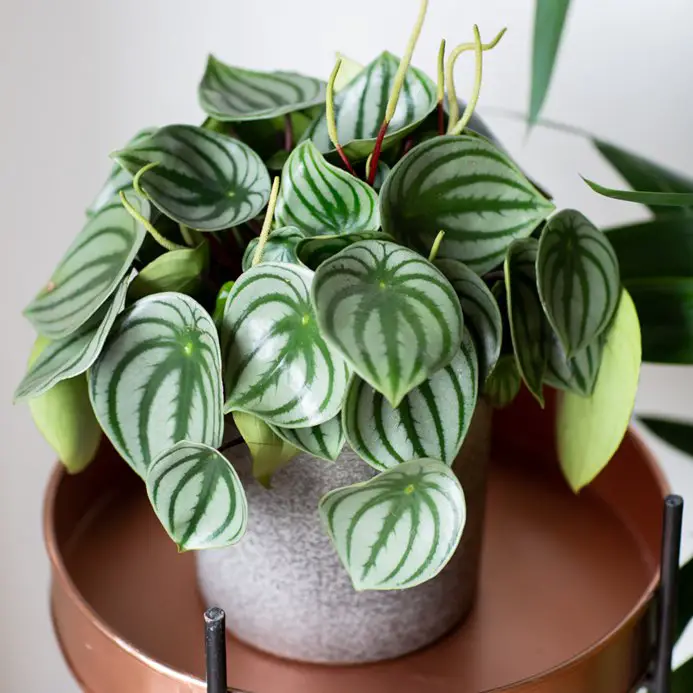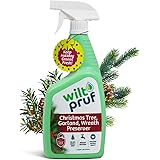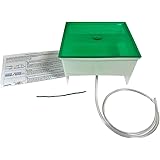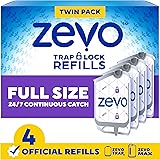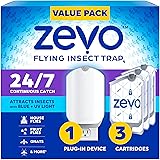The Watermelon Peperomia (Peperomia argyreia) is a delightful houseplant that brings a touch of the tropics into your home with its striking foliage. Named for its resemblance to miniature watermelons, this plant is not only visually appealing but also relatively easy to care for, making it a favorite among both beginner and experienced plant enthusiasts. In 2025, indoor plants continue to trend, with the Watermelon Peperomia riding high on the popularity wave, particularly among millennial and Gen Z plant parents.
According to recent statistics from the National Gardening Association, indoor plant sales have increased by over 20% in the past five years, with a significant portion attributed to easy-care, visually attractive plants like the Watermelon Peperomia. This comprehensive guide will walk you through everything you need to know to keep your Watermelon Peperomia thriving, from the perfect potting mix to effective propagation techniques.
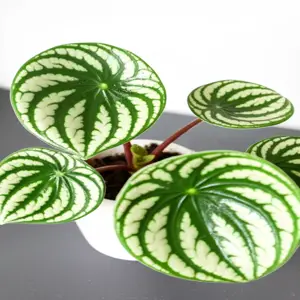
A vibrant Watermelon Peperomia bringing joy indoors.
Understanding the Watermelon Peperomia
Before diving into the care specifics, let’s understand a bit more about this charming plant. The Watermelon Peperomia, native to South America (specifically Brazil and Bolivia), belongs to the Piperaceae family, which also includes pepper plants. Its distinctive leaves are characterized by silver stripes on a dark green background, creating the illusion of a miniature watermelon rind. Unlike some houseplants that require constant attention, the Watermelon Peperomia is known for its resilience and adaptability.
However, like any plant, it has specific needs that, when met, will result in a healthy and happy specimen. Understanding these needs is the key to success. Current trends in indoor gardening emphasize sustainability and eco-friendly practices, which are highly relevant to Watermelon Peperomia care. For example, using recycled pots and organic soil mixes aligns with these trends and promotes plant health.
Botanical Background
Peperomia argyreia is a relatively small plant, typically growing to a height of 6-8 inches. It’s a perennial epiphyte in its natural habitat, meaning it often grows on other plants or rocks, obtaining moisture and nutrients from the air and rain. This epiphytic nature is crucial to understanding its care requirements, particularly regarding soil drainage and watering frequency.
The plant’s leaves are thick and succulent-like, allowing it to store water, making it relatively drought-tolerant. The stems are reddish-purple, adding another layer of visual interest. While the plant occasionally produces small, inconspicuous flowers on slender spikes, it’s primarily grown for its beautiful foliage.
Why is it Popular?
The Watermelon Peperomia’s popularity stems from several factors:
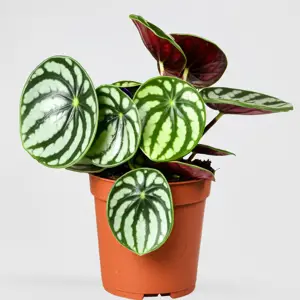
peperomia argyreia care
- Unique Appearance: The watermelon-like foliage is undeniably eye-catching and adds a unique touch to any indoor space.
- Easy Care: As mentioned earlier, it’s relatively low-maintenance, making it suitable for beginners.
- Compact Size: Its small size makes it ideal for apartments, desks, and small spaces.
- Air Purifying Qualities: While not as potent as some other air-purifying plants, it does contribute to cleaner indoor air.
- Pet-Friendly: It’s considered non-toxic to cats and dogs, making it a safe choice for pet owners (although it’s always best to prevent pets from ingesting any houseplants). Regulations regarding the sale of non-toxic houseplants are becoming increasingly common, driven by consumer demand for pet- and child-safe options.
Optimal Growing Conditions for Watermelon Peperomia
Providing the right growing conditions is essential for the health and well-being of your Watermelon Peperomia. Let’s break down the key factors:
Light Requirements
The Watermelon Peperomia thrives in bright, indirect light. Direct sunlight can scorch its delicate leaves, leading to unsightly brown spots. However, insufficient light can result in leggy growth and faded leaf patterns. Here’s a breakdown:
- Ideal: Bright, indirect light. East-facing windows are often ideal, providing gentle morning sun. A north-facing window can also work if the light is bright enough. If using a south- or west-facing window, place the plant a few feet away from the window or use a sheer curtain to filter the light.
- Avoid: Direct sunlight, especially during the hottest part of the day. Also, avoid placing the plant in a dark corner, as it will struggle to thrive.
- Signs of Too Much Light: Brown, crispy leaves, especially on the side facing the window.
- Signs of Too Little Light: Leggy growth (long stems with sparse leaves), faded leaf patterns, and slow growth.
Real-World Example: Sarah, a plant enthusiast from Chicago, initially placed her Watermelon Peperomia on a sunny windowsill. Within a week, she noticed brown spots appearing on the leaves. After moving the plant to a spot a few feet away from the window, the scorching stopped, and the plant began to thrive.
Light Meters: Using a light meter can help you accurately measure the light levels in different areas of your home. Aim for a reading between 10,000 and 20,000 lux for optimal Watermelon Peperomia growth.
Watering Techniques
Watering is perhaps the most crucial aspect of Watermelon Peperomia care. Overwatering is a common killer, leading to root rot and other fungal diseases. Underwatering, while less common, can also stress the plant. The key is to find the right balance.
- The “Soak and Dry” Method: Allow the top inch or two of soil to dry out completely before watering thoroughly. This method mimics the plant’s natural growing conditions, where it experiences periods of dryness followed by heavy rainfall.
- How to Water: When the soil is dry, water the plant thoroughly until water drains out of the drainage holes. Empty the saucer beneath the pot to prevent the plant from sitting in standing water.
- Water Quality: Use room-temperature water. Avoid using hard water or water with high levels of chlorine or fluoride, as these can damage the plant. Filtered water or rainwater is ideal.
- Frequency: Watering frequency will vary depending on the time of year, temperature, humidity, and pot size. In general, you’ll need to water more frequently during the growing season (spring and summer) and less frequently during the dormant season (fall and winter). A good rule of thumb is to water every 1-2 weeks during the growing season and every 2-4 weeks during the dormant season.
- Signs of Overwatering: Yellowing leaves, mushy stems, and a foul odor emanating from the soil.
- Signs of Underwatering: Drooping leaves, dry and crispy leaf edges, and stunted growth.
Real-World Example: David, a new plant owner, was so excited about his Watermelon Peperomia that he watered it every day. Within a few weeks, the leaves started to turn yellow and droop.
He contacted a local plant expert, who advised him to reduce his watering frequency. After switching to the “soak and dry” method, David’s plant quickly recovered.
Moisture Meters: Using a moisture meter can take the guesswork out of watering. Insert the meter into the soil and water only when the reading indicates that the soil is dry.
Soil Composition
The right soil is crucial for providing proper drainage and aeration. Watermelon Peperomias prefer well-draining soil that retains some moisture but doesn’t become waterlogged. A typical potting mix for Watermelon Peperomias consists of the following:
- Peat Moss or Coco Coir: These materials help retain moisture and provide a good foundation for the soil.
- Perlite or Vermiculite: These materials improve drainage and aeration.
- Compost or Worm Castings: These provide essential nutrients for the plant.
Recommended Mix: A good starting point is a mix of 1 part peat moss or coco coir, 1 part perlite or vermiculite, and 1 part compost or worm castings. You can also use a commercially available potting mix specifically formulated for succulents or cacti, as these mixes tend to be well-draining.
DIY Soil Mix: Creating your own soil mix allows you to customize the composition to suit your plant’s specific needs. Experiment with different ratios to find what works best for you.
Repotting: Repot your Watermelon Peperomia every 1-2 years, or when it becomes root-bound. Choose a pot that is only slightly larger than the previous one. Repotting provides the plant with fresh soil and allows you to inspect the roots for any signs of disease or pests.
Temperature and Humidity
Watermelon Peperomias thrive in warm temperatures and moderate humidity. They are not cold-hardy and should be protected from frost. Here’s a more detailed look:
- Temperature: The ideal temperature range for Watermelon Peperomias is between 65°F and 80°F (18°C and 27°C). Avoid exposing the plant to temperatures below 50°F (10°C).
- Humidity: Watermelon Peperomias prefer moderate humidity, around 40-60%. In dry climates, you may need to increase the humidity around the plant.
Increasing Humidity: There are several ways to increase humidity around your Watermelon Peperomia:
- Humidifier: Using a humidifier is the most effective way to increase humidity.
- Pebble Tray: Place the pot on a tray filled with pebbles and water. As the water evaporates, it will increase the humidity around the plant.
- Grouping Plants: Grouping plants together creates a microclimate with higher humidity.
- Misting: Misting the plant with water can temporarily increase humidity, but it’s not a long-term solution and can sometimes lead to fungal problems if the leaves stay wet for too long.
Real-World Example: Maria, who lives in a dry desert climate, struggled to keep her Watermelon Peperomia healthy. After purchasing a humidifier, her plant’s leaves became much more vibrant and lush.
Fertilizing Your Watermelon Peperomia
Watermelon Peperomias are not heavy feeders, but they do benefit from regular fertilization during the growing season. Over-fertilizing can lead to salt buildup in the soil, which can damage the plant. Here’s what you need to know:
- Type of Fertilizer: Use a balanced liquid fertilizer diluted to half strength. A 20-20-20 fertilizer is a good option. You can also use a fertilizer specifically formulated for succulents or cacti.
- Frequency: Fertilize every 2-4 weeks during the growing season (spring and summer). Do not fertilize during the dormant season (fall and winter).
- How to Fertilize: Water the plant thoroughly before fertilizing. This will help prevent fertilizer burn. Pour the diluted fertilizer solution over the soil, avoiding the leaves.
- Signs of Over-Fertilizing: Brown leaf tips, white crust on the soil surface, and stunted growth.
Organic Options: Consider using organic fertilizers like compost tea or worm castings. These provide nutrients in a slow-release form and are less likely to cause salt buildup in the soil. The trend towards organic and sustainable gardening practices is growing, with many gardeners opting for natural fertilizers to minimize their environmental impact.
| Aspect | Ideal Condition | What to Avoid |
|---|---|---|
| Light | Bright, indirect light | Direct sunlight, dark corners |
| Watering | Soak and dry method | Overwatering, underwatering |
| Soil | Well-draining potting mix | Heavy, waterlogged soil |
| Temperature | 65°F – 80°F (18°C – 27°C) | Temperatures below 50°F (10°C) |
| Humidity | 40-60% | Very low humidity |
| Fertilizing | Balanced liquid fertilizer (diluted) every 2-4 weeks during growing season | Over-fertilizing, fertilizing during dormant season |
Propagating Watermelon Peperomia
Propagating Watermelon Peperomia is a rewarding way to expand your plant collection and share these beauties with friends. There are several methods you can use, each with its own advantages:
Leaf Cuttings
Leaf cuttings are the most common and easiest method for propagating Watermelon Peperomia. Here’s how to do it:
- Select a Healthy Leaf: Choose a mature, healthy leaf with a long petiole (the stem that connects the leaf to the main stem).
- Cut the Leaf: Using a clean, sharp knife or scissors, cut the leaf from the plant, leaving about 1-2 inches of petiole attached.
- Rooting Medium: You can root the leaf cutting in water or directly in soil.
- Water Propagation: Place the petiole in a glass of water, ensuring that the leaf itself is not submerged. Change the water every few days. Roots should start to develop within a few weeks. Once the roots are about an inch long, you can transplant the cutting into soil.
- Soil Propagation: Dip the cut end of the petiole in rooting hormone (optional) and plant it in a small pot filled with well-draining potting mix. Water lightly and cover the pot with a plastic bag or humidity dome to create a humid environment. Keep the soil moist but not soggy.
- Provide Light and Warmth: Place the cutting in a warm, bright location, but avoid direct sunlight.
- Be Patient: It can take several weeks or even months for roots to develop and new growth to emerge.
Real-World Example: Emily, a college student, successfully propagated her Watermelon Peperomia using leaf cuttings. She placed the cuttings in small glass jars on her windowsill and was thrilled to see roots developing within a few weeks. She then potted the rooted cuttings in small terracotta pots and gave them as gifts to her friends.
Rooting Hormone: While not essential, using rooting hormone can speed up the rooting process and increase your chances of success. Follow the instructions on the rooting hormone package.
Stem Cuttings
Stem cuttings are another effective method for propagating Watermelon Peperomia, especially if you have a plant with long stems.
- Select a Healthy Stem: Choose a healthy stem with several leaves.
- Cut the Stem: Using a clean, sharp knife or scissors, cut the stem into sections, each containing at least one leaf node (the point where a leaf emerges from the stem).
- Prepare the Cuttings: Remove the bottom leaves from each cutting, leaving only the top leaves. This will prevent the leaves from rotting in the soil.
- Rooting Medium: You can root the stem cuttings in water or directly in soil, similar to leaf cuttings.
- Rooting Hormone: Dip the cut end of each cutting in rooting hormone (optional).
- Plant the Cuttings: Plant the cuttings in a small pot filled with well-draining potting mix. Water lightly and cover the pot with a plastic bag or humidity dome to create a humid environment.
- Provide Light and Warmth: Place the cuttings in a warm, bright location, but avoid direct sunlight.
- Be Patient: It can take several weeks or even months for roots to develop and new growth to emerge.
Stem Cuttings vs. Leaf Cuttings: Stem cuttings tend to root faster than leaf cuttings, as they already have a stem structure in place. However, leaf cuttings are a good option if you only have a few leaves to work with.
Division
Division is a method of propagation that involves separating a mature plant into two or more smaller plants. This method is best suited for plants that have multiple stems or clumps of leaves.
- Remove the Plant from the Pot: Gently remove the Watermelon Peperomia from its pot.
- Separate the Plant: Using your hands or a clean knife, carefully separate the plant into two or more sections, ensuring that each section has its own roots and stems.
- Repot the Divisions: Repot each division into a separate pot filled with well-draining potting mix.
- Water Thoroughly: Water the newly potted divisions thoroughly and place them in a warm, bright location, but avoid direct sunlight.
Division Tips: Be gentle when separating the plant to avoid damaging the roots. If the roots are tightly tangled, you may need to use a knife to carefully cut them apart. Division is best done in the spring or summer, when the plant is actively growing.
Propagation and Sustainability: Propagating your Watermelon Peperomia is a sustainable way to increase your plant collection without having to purchase new plants. It also allows you to share your love of plants with others.
Common Problems and Solutions
Even with the best care, Watermelon Peperomias can sometimes encounter problems. Here’s a guide to common issues and how to address them:
Root Rot
Problem: Root rot is a fungal disease that occurs when the roots of the plant are constantly exposed to excessive moisture. It’s one of the most common problems affecting Watermelon Peperomias.
Symptoms: Yellowing leaves, mushy stems, a foul odor emanating from the soil, and wilting despite adequate watering.
Solutions:
- Remove the Plant: Carefully remove the plant from its pot and inspect the roots.
- Trim Affected Roots: Using clean, sharp scissors or a knife, trim away any brown, mushy, or rotten roots. Healthy roots should be firm and white or light brown.
- Repot in Fresh Soil: Repot the plant in a clean pot filled with fresh, well-draining potting mix.
- Improve Drainage: Ensure that the pot has adequate drainage holes and avoid using heavy, waterlogged soil.
- Adjust Watering: Reduce your watering frequency and allow the top inch or two of soil to dry out completely before watering again.
- Fungicide (Optional): In severe cases, you may need to treat the plant with a fungicide. Follow the instructions on the fungicide package.
Prevention: Prevention is the best cure for root rot. Avoid overwatering, use well-draining soil, and ensure that the pot has adequate drainage holes.
Leaf Spot
Problem: Leaf spot is a fungal or bacterial disease that causes spots to appear on the leaves of the plant.
Symptoms: Small, circular spots on the leaves, which may be brown, black, or yellow. The spots may eventually merge together and cause the leaves to drop off.
Solutions:
- Remove Affected Leaves: Remove any leaves that are showing signs of leaf spot.
- Improve Air Circulation: Ensure that the plant has good air circulation. Avoid overcrowding plants and use a fan to circulate the air.
- Reduce Humidity: Reduce the humidity around the plant, as high humidity can promote the growth of fungal and bacterial pathogens.
- Fungicide or Bactericide: Treat the plant with a fungicide or bactericide, depending on the cause of the leaf spot. Follow the instructions on the product package.
Prevention: Avoid getting water on the leaves when watering the plant, as this can create a favorable environment for pathogens to grow. Also, regularly inspect the plant for any signs of disease and take action immediately if you notice any problems.
Pests
Watermelon Peperomias are relatively pest-resistant, but they can sometimes be affected by common houseplant pests such as mealybugs, spider mites, and aphids.
Mealybugs:
- Symptoms: Small, white, cottony masses on the leaves and stems.
- Solutions:
- Isolate the Plant: Isolate the affected plant to prevent the pests from spreading to other plants.
- Manual Removal: Remove the mealybugs by hand using a cotton swab dipped in rubbing alcohol.
- Insecticidal Soap or Neem Oil: Spray the plant with insecticidal soap or neem oil, following the instructions on the product package.
Spider Mites:
- Symptoms: Fine webbing on the leaves and stems, tiny moving dots (the spider mites themselves). Leaves may appear stippled or discolored.
- Solutions:
- Increase Humidity: Spider mites thrive in dry conditions, so increasing the humidity around the plant can help deter them.
- Wash the Plant: Wash the plant with a strong stream of water to dislodge the spider mites.
- Insecticidal Soap or Neem Oil: Spray the plant with insecticidal soap or neem oil, following the instructions on the product package.
Aphids:
- Symptoms: Small, green, brown, or black insects on the leaves and stems. Leaves may be sticky or distorted.
- Solutions:
- Wash the Plant: Wash the plant with a strong stream of water to dislodge the aphids.
- Insecticidal Soap or Neem Oil: Spray the plant with insecticidal soap or neem oil, following the instructions on the product package.
General Pest Prevention: Regularly inspect your Watermelon Peperomia for pests. Wipe down the leaves with a damp cloth to remove dust and debris. Provide good air circulation and avoid overcrowding plants. Consider using a systemic insecticide as a preventative measure, but only if necessary and with caution.
Leaf Drop
Problem: Sudden leaf drop can be a sign of various issues, including overwatering, underwatering, temperature stress, or pest infestation.

watermelon peperomia plant
Solutions:
- Assess Watering: Check the soil moisture to determine if you are overwatering or underwatering. Adjust your watering frequency accordingly.
- Check Temperature: Ensure that the plant is not exposed to extreme temperatures or drafts.
- Inspect for Pests: Carefully inspect the plant for any signs of pests. Treat any infestations promptly.
- Provide Adequate Light: Ensure that the plant is receiving adequate light. Move the plant to a brighter location if necessary.
Leaf Drop and Acclimation: It’s normal for a Watermelon Peperomia to drop a few leaves when it’s first brought home, as it adjusts to its new environment. However, if the leaf drop is excessive or persists for more than a few weeks, it’s a sign that something is wrong.
Stunted Growth
Problem: Stunted growth can be caused by a variety of factors, including insufficient light, nutrient deficiency, or root-bound conditions.
Solutions:
- Provide Adequate Light: Ensure that the plant is receiving adequate light. Move the plant to a brighter location if necessary.
- Fertilize Regularly: Fertilize the plant every 2-4 weeks during the growing season with a balanced liquid fertilizer.
- Repot if Necessary: If the plant is root-bound, repot it into a larger pot with fresh potting mix.
- Check for Pests: Inspect the plant for pests, as infestations can stunt growth.
Dormancy: Keep in mind that Watermelon Peperomias typically experience a period of dormancy during the fall and winter, during which their growth slows down. This is normal and doesn’t necessarily indicate a problem.
Displaying Your Watermelon Peperomia
The Watermelon Peperomia is a versatile plant that can be displayed in a variety of ways to enhance your home decor. Here are some ideas:
Potting Options
- Terracotta Pots: Terracotta pots are a classic choice for Watermelon Peperomias. They are porous, which helps to improve drainage and aeration.
- Ceramic Pots: Ceramic pots come in a wide variety of colors and styles, allowing you to match them to your decor. Choose a ceramic pot with a drainage hole.
- Hanging Baskets: Watermelon Peperomias can also be grown in hanging baskets, which allows their leaves to cascade down.
- Self-Watering Pots: Self-watering pots can be a good option for busy plant owners, as they help to regulate soil moisture.
- Recycled Containers: Consider using recycled containers such as tin cans or glass jars to pot your Watermelon Peperomia. This is a sustainable and eco-friendly option. Using recycled materials is in line with current trends focused on environmentally conscious living.
Placement Ideas
- Windowsills: Windowsills are a great place to display Watermelon Peperomias, as they provide bright, indirect light.
- Shelves: Place your Watermelon Peperomia on a shelf to add a touch of greenery to your living space.
- Desks: Watermelon Peperomias are a great addition to desks, as they can help to purify the air and create a more calming work environment.
- Bathrooms: Bathrooms with bright, indirect light are a good place to display Watermelon Peperomias, as they enjoy the humidity.
- Plant Stands: Use plant stands to elevate your Watermelon Peperomia and create a focal point in your room.
Companion Plants
Consider pairing your Watermelon Peperomia with other plants that have similar care requirements. Some good companion plants include:
- Other Peperomia Species: Peperomias come in a wide variety of shapes, sizes, and colors, so you can create a diverse and interesting display by grouping different species together.
- Succulents: Succulents have similar watering and light requirements as Watermelon Peperomias, making them a good choice for companion plants.
- Hoyas: Hoyas are another type of plant that enjoys bright, indirect light and well-draining soil.
- Air Plants: Air plants can be displayed alongside Watermelon Peperomias to add a touch of whimsy to your decor.
Creating a Terrarium
Watermelon Peperomias can also be grown in terrariums, which are enclosed glass containers that create a humid environment. Terrariums can be a fun and creative way to display your plants, but they require careful maintenance to prevent fungal problems.
Watermelon Peperomia and Air Purification
While the Watermelon Peperomia is primarily valued for its aesthetic appeal, it also contributes to improving indoor air quality. While not as effective as some larger plants, it still helps to remove toxins from the air and increase oxygen levels. NASA’s Clean Air Study, while conducted decades ago, remains a relevant reference for understanding the air-purifying capabilities of various houseplants. Though Watermelon Peperomia wasn’t specifically tested, plants in the Peperomia family generally contribute to reducing indoor pollutants like formaldehyde and xylene.
Benefits of Air Purification: Improved air quality can lead to several benefits, including reduced allergies, improved sleep, and increased productivity. The trend towards biophilic design, which emphasizes incorporating natural elements into indoor spaces, further highlights the importance of air-purifying plants.
Maximizing Air Purification: To maximize the air-purifying benefits of your Watermelon Peperomia, keep its leaves clean and dust-free. Also, consider placing multiple plants throughout your home to increase the overall air purification effect.
Ethical Considerations and Plant Sourcing
When purchasing a Watermelon Peperomia, it’s important to consider ethical and environmental factors. Support nurseries and plant shops that prioritize sustainable practices and responsible sourcing. Avoid purchasing plants that have been wild-collected, as this can harm natural ecosystems. Look for plants that have been propagated in nurseries using sustainable methods. Also, consider purchasing from local nurseries to reduce the environmental impact of transportation. The growing awareness of environmental issues has led to increased regulations on plant sourcing and trade, particularly for rare or endangered species. While Watermelon Peperomia is not currently endangered, it’s still important to be mindful of its origins and support sustainable practices.

peperomia care guide
FAQ: Your Watermelon Peperomia Questions Answered
Why are the leaves of my Watermelon Peperomia turning yellow?
Yellowing leaves are often a sign of overwatering. Allow the soil to dry out completely between waterings. It can also be caused by nutrient deficiency, so consider fertilizing your plant during the growing season.
What should I do if my Watermelon Peperomia is drooping?
Drooping leaves can indicate either overwatering or underwatering. Check the soil moisture to determine the cause. If the soil is dry, water the plant thoroughly. If the soil is wet, allow it to dry out before watering again.
How often should I fertilize my Watermelon Peperomia?
Fertilize your Watermelon Peperomia every 2-4 weeks during the growing season (spring and summer) with a balanced liquid fertilizer diluted to half strength.
What type of soil is best for Watermelon Peperomia?
Watermelon Peperomias prefer well-draining soil. A good mix consists of 1 part peat moss or coco coir, 1 part perlite or vermiculite, and 1 part compost or worm castings. You can also use a commercially available potting mix specifically formulated for succulents or cacti.
How much light does a Watermelon Peperomia need?
Watermelon Peperomias thrive in bright, indirect light. Avoid direct sunlight, which can scorch their leaves.
Is Watermelon Peperomia safe for pets?
Yes, Watermelon Peperomia is considered non-toxic to cats and dogs.
How do I propagate Watermelon Peperomia?
You can propagate Watermelon Peperomia using leaf cuttings, stem cuttings, or division.
Why are the leaves of my Watermelon Peperomia developing brown spots?
Brown spots on the leaves can be caused by direct sunlight, overwatering, or fungal diseases. Adjust the plant’s location or watering habits as needed.
My Watermelon Peperomia isn’t growing. What could be the reason?
Stunted growth can be caused by insufficient light, nutrient deficiency, or root-bound conditions. Ensure that the plant is receiving adequate light and fertilizer, and repot it into a larger pot if necessary.
The Future of Watermelon Peperomia Care
Technology is increasingly playing a role in plant care. Smart sensors and automated watering systems can help to optimize growing conditions and prevent common problems. AI-powered apps can identify plant diseases and pests, providing personalized care recommendations. As technology continues to evolve, we can expect to see even more innovative solutions for plant care, making it easier than ever to keep our Watermelon Peperomias thriving.
Furthermore, research into plant genetics and breeding may lead to the development of new Watermelon Peperomia cultivars with enhanced disease resistance, improved air purification capabilities, and even more striking foliage patterns. The future of Watermelon Peperomia care is bright, with exciting possibilities on the horizon.
Auto Amazon Links: No products found.
Perfect Plants Christmas Tree Saver 8oz. | Easy Use Xmas Tree Preserver Food | Have Healthy Green Christmas Trees All Holiday Season
$9.97 (as of November 26, 2025 23:26 GMT +00:00 - More info- Product prices and availability are accurate as of the date/time indicated and are subject to change. Any price and availability information displayed on [relevant Amazon Site(s), as applicable] at the time of purchase will apply to the purchase of this product.
Wilt-Pruf® Christmas Tree/Cutting Preserver Spray |Preserves Christmas Trees, Wreaths, Garlands, Cuttings and Carved Pumpkins | Reduces Needle Drop | Keeps Cut Trees Fresh Longer | Natural (32 oz)
$21.99 (as of November 26, 2025 23:26 GMT +00:00 - More info- Product prices and availability are accurate as of the date/time indicated and are subject to change. Any price and availability information displayed on [relevant Amazon Site(s), as applicable] at the time of purchase will apply to the purchase of this product.
Christmas Tree Watering Funnel – 39 Inch Adjustable 3-Section Design, Reusable & Spill-Free, Easy Watering for Real Christmas Trees
$13.88 (as of November 26, 2025 23:26 GMT +00:00 - More info- Product prices and availability are accurate as of the date/time indicated and are subject to change. Any price and availability information displayed on [relevant Amazon Site(s), as applicable] at the time of purchase will apply to the purchase of this product.
HoHoHoH2o Automatic Christmas Tree Watering System Device, Santa’s Tree Helper Keeps Your Christmas Tree Healthy and Fresh, Refillable 2.5 gallons Capacity Box - Red/Snowflakes
$99.95 (as of November 26, 2025 23:26 GMT +00:00 - More info- Product prices and availability are accurate as of the date/time indicated and are subject to change. Any price and availability information displayed on [relevant Amazon Site(s), as applicable] at the time of purchase will apply to the purchase of this product.
Automatic Christmas Tree Watering System | Reduce Needle Loss | Never Have a Dry Stand | Evergreen Helper® | US Patent 12,102,249
$28.49 (as of November 26, 2025 23:26 GMT +00:00 - More info- Product prices and availability are accurate as of the date/time indicated and are subject to change. Any price and availability information displayed on [relevant Amazon Site(s), as applicable] at the time of purchase will apply to the purchase of this product.
ThermoPro TP16 Large LCD Digital Cooking Food Meat Thermometer for Smoker Oven Kitchen BBQ Grill Thermometer Clock Timer with Stainless Steel Temperature Probe
$17.99 (as of November 26, 2025 14:50 GMT +00:00 - More info- Product prices and availability are accurate as of the date/time indicated and are subject to change. Any price and availability information displayed on [relevant Amazon Site(s), as applicable] at the time of purchase will apply to the purchase of this product.
Zevo Flying Insect Trap Official Refill Cartridges - Fits Both Zevo Trap & MAX Indoor Fly Trap - Authentic Trap+Lock Technology to Catch Gnats, House & Fruit Flys (4 Official Refill Cartridges)
$13.47 (as of November 26, 2025 14:50 GMT +00:00 - More info- Product prices and availability are accurate as of the date/time indicated and are subject to change. Any price and availability information displayed on [relevant Amazon Site(s), as applicable] at the time of purchase will apply to the purchase of this product.
Victor Mouse Traps M150-12, Metal Pedal, Sustainably Sourced FSC Wood, Wooden Mouse Traps, 12 Metal Pedal Traps
$9.79 (as of November 26, 2025 14:50 GMT +00:00 - More info- Product prices and availability are accurate as of the date/time indicated and are subject to change. Any price and availability information displayed on [relevant Amazon Site(s), as applicable] at the time of purchase will apply to the purchase of this product.
Zevo Flying Insect Trap & 3 Refill Cartridges - Plug in Fly Trap & Indoor Bug Catcher for Gnats, House & Fruit Flies - Blue & UV Light Technology, Mess-Free Alternative to Bug Zapper
$25.96 (as of November 26, 2025 14:50 GMT +00:00 - More info- Product prices and availability are accurate as of the date/time indicated and are subject to change. Any price and availability information displayed on [relevant Amazon Site(s), as applicable] at the time of purchase will apply to the purchase of this product.
TERRO Ant Killer Bait Stations T300B - Liquid Bait to Eliminate Ants - Bait System - 12 Count Stations for Effective Indoor Ant Control
$10.86 (as of November 26, 2025 14:50 GMT +00:00 - More info- Product prices and availability are accurate as of the date/time indicated and are subject to change. Any price and availability information displayed on [relevant Amazon Site(s), as applicable] at the time of purchase will apply to the purchase of this product.

